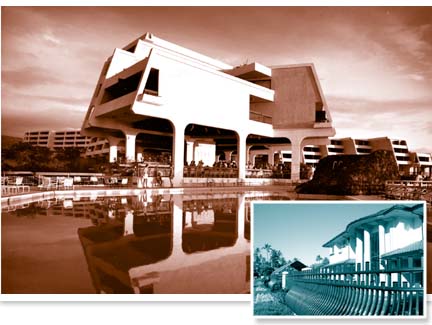

|
TheBuzz Erika Engle |
Stucco not stylin’
in Hawaii, experts sayItalian villas are great -- for Italy, not Hawaii. Stucco has its place, but not in Hawaii.
"You don't have to reach halfway around the world for another architectural style when there are many good native architectural styles already," said Julius Shulman, 92, a world-renowned architectural photographer.
To do so is "not only silly, it's stupid," he said.
"Hawaiian architecture doesn't have to stand second-fiddle to anyone else's."
Concern over the proliferation of non-Hawaii architecture has the local design community abuzz and fixing to fight.
"In Australia, 3 percent of buildings are designed by architects. Here, in Hawaii, it's about 1 percent," said Patrick Tozier, principal of ANA Architecture.
Nowadays, the majority of buildings are designed by contractors and "developers that have their own in-house guys," he said. "And not all architects are designers."
Tozier and others are "sort of heading, hopefully a movement, to try and see what we can do to move in a better direction."
COURTESY OF JULIUS SHULMAN (ABOVE) AND PATRICK TOZIER (INSET)
The Kona Surf Hotel, above, is an example of the desired Hawaiian architecture while a gated residence under construction on Kahala Avenue, inset, is among those designs that has created a controversy among those in the design community.
The University of Hawaii School of Architecture, its alumni and the Hawaii Chapter of the American Institute of Architects are organizing a series of events at which Shulman will speak next week.
About 600 interior designers, photographers, artists, politicians, real estate agents, contractors, developers, architecture school faculty and staff, urban planners and architects have been invited to attend, but most of the events are free and open to the public.
An exhibition of Shulman's photography will be open from 9 a.m. to 3 p.m. Sept. 23 to Nov. 14 at the Shen Gallery at the school. Shulman will conduct a series of free workshops, forums and book-signing receptions at the school from Sept. 24 to 26 and will address an invitation-only crowd Sept. 27. Tozier is handling inquiries and reservations through Sept. 25 at 227-3352.
Shulman's body of work in architectural photography in 44 states and around the world is contained in numerous publications, including more than a half-dozen books.
He photographed the Kona Surf Hotel for the old Interisland Resorts company and still praises the properties' locally generated architecture. "They have everything keyed to the beauty of the Hawaiian landscape."
A big gripe of Shulman's is that "the control of the land, the environment and the ecology of our surroundings is, unfortunately, in the hands of big investors who want to squeeze every ugly dollar out of every acre." He speaks to groups about ways to make more profit per square foot without building monstrosities.
"An Italian villa in Honolulu? Who needs it? I'll be talking about this also," Shulman said.
Cause and effect
Kahala used to be a community of subdued rooflines but that's increasingly not the case. "You could hardly see the homes, they were set back. What we're doing now is getting right up to the setback, getting right up to the highest building envelopes. We're throwing facades in people's faces and the facades are as cheap as they come, stucco," Tozier said, pulling no punches."What irks me is the transplanting of styles, especially Mediterranean and Tuscan."
Tozier and his colleagues bemoan the non-Hawaiian design, stucco, use of other cheap materials and underutilization of their skills.
"We need a little bit of that old midcentury Hawaii where designers were sought after for key projects," such as Vladimir Ossipoff and Pete Wimberly, Tozier said.
"I think the architect and the designer need to now start being proactive and promoting better style for Hawaii."
"Frankly many of the designers now don't have that sense. They're learning it in modern architecture in school, but once they get into the world, the bottom line is money and ease of process. 'Whatever the client wants. Why argue?' What results in the end is exactly what the clients want, which is not what architects should be doing for the overall balance of the state's architecture."
"We, as designers, need to take back our integrity and move toward solid design principles with a little taste," said Tozier.
"This whole trip about a Hawaiian sense of place has been grossly misinterpreted. We're thinking plantation architecture is truly Hawaiian, but Hawaiian architecture can move in the direction of topical, natural design and also about form, too."
Fighting back could include "good conceptual competitions," better self-promotion and some sort of "some kind of council that looks at what's going on," Tozier said.
See the Columnists section for some past articles.
Erika Engle is a reporter with the Star-Bulletin. Call 529-4302, fax 529-4750 or write to Erika Engle, Honolulu Star-Bulletin, 500 Ala Moana Blvd., No. 7-210, Honolulu, HI 96813. She can also be reached at: eengle@starbulletin.com
